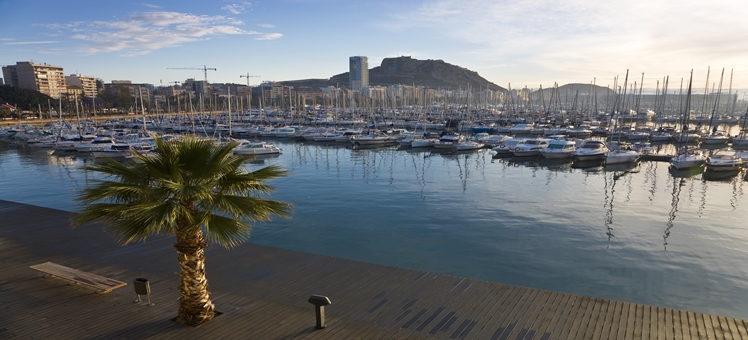
Alicante is the gateway to the Costa Blanca in eastern Spain, where the mountains meet the sea. This vibrant university town is popular with millions of tourists who fly into Alicante airport each year. For many travelers, the long, sandy beaches are the main temptation but Alicante’s many charms include its old town, hilltop castle, art collections, history, fine foods, nightlife and fiery fiestas.
 Sarah FarrellMy Destination local expert onAlicante
Sarah FarrellMy Destination local expert onAlicante Beach life
Beach life
Alicante’s several kilometers of golden sandy beaches and beautiful coves with crystal-clear waters provide a popular playground for sunbathers and water sports enthusiasts. The emblematic Santa Barbara Castle provides a dramatic backdrop to the city center Postiguet Beach, which is a long sandy beach next door to the chic marina. History lovers head for Albufereta Beach, home to the harbor where Alicante’s origins lie. Lined with restaurants and bars, most people head for San Juan’s golden beach while people seeking a beautiful haven like the peace and tranquility of the rocky Cabo de la Huera coves.
Festivals and fiestas
Alicante enjoys explosive fiestas throughout the year. Hundreds of satirical papier-mâché statues as tall as buildings take center stage in the San Juan festival in June. The fiesta comes to a fiery end when the statues are burnt to the ground. Running street battles with gunpowder and plots transform Alicante streets for the Moors and Christians Festival. The drama continues on a more somber note with massive sculptures showing Easter scenes paraded around the streets during Holy Week. Spain’s second largest pilgrimage starts in Alicante when about 200,000 pilgrims walk to the Santa Faz Monastery.
Art and culture
The heart of Alicante city is a haven for art lovers. The 18th century Alicante Town Hall has a plaque marking the official sea level for Spain. Nearby is the 17th century San Nicholas Cathedral, Santa Maria Basilica, which is Alicante’s oldest church, and the iconic Santa Barbara Castle which is one of Spain’s largest medieval fortresses. A beautiful 17th century house has been turned into the Museum of Contemporary Art, whose collection includes works by world-famous Spanish artists such as Picasso and Dali, while an 18th century palace is home to the Gravina Fine Arts Museum.
Sports and hobbies
This waterside city sets the scene for the start of the prestigious Volvo Ocean Race for the third time - in 2014. The Mediterranean is a playground for water sports including sailing, surfing and diving. The long, sunny days are also a major lure for golfers, tennis players and athletes, while cyclists – including professional teams – enjoy the challenge of the hairpin bends on the mountains as well as the scenic coastal routes. Football fans can enjoy the drama on and off the pitch at a match of one of Alicante city’s two football teams – Hercules and Alicante.
Parks and gardens
One of the prettiest places for a stroll is Alicante’s seafront promenade, the Explanada de España, running from the port to the tree-lined Canalejas Park with plenty of shade against the heat of the sun. La Ereta Park has fantastic views of San Nicolas Cathedral and the Port while visitors can enjoy the lake and waterfalls at El Palmeral Park. Alicante’s largest park, Lo Morant, has pine groves and sports facilities. To find out more about the geography of the Alicante region, head to Monte Tossal Park, whose theme park proves learning can be fun.